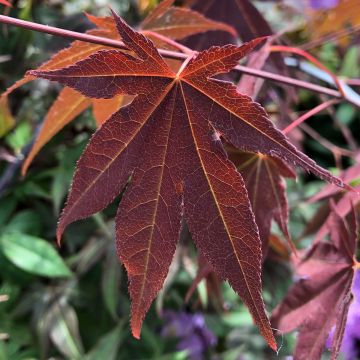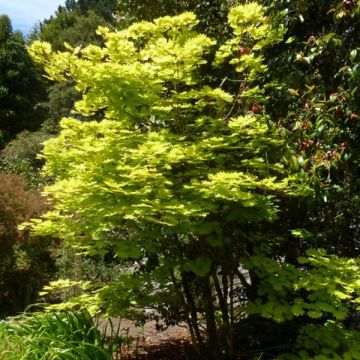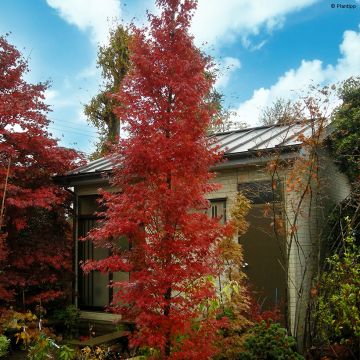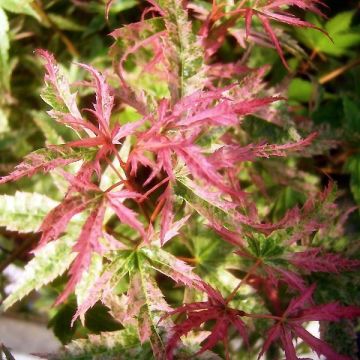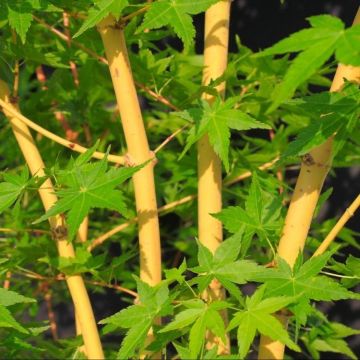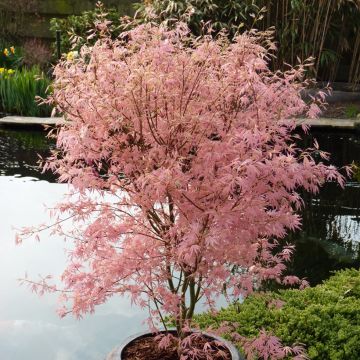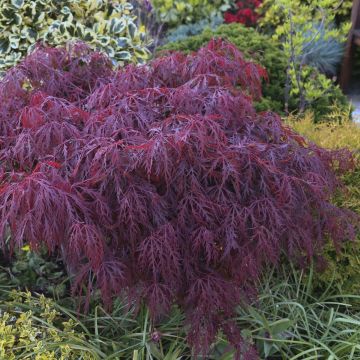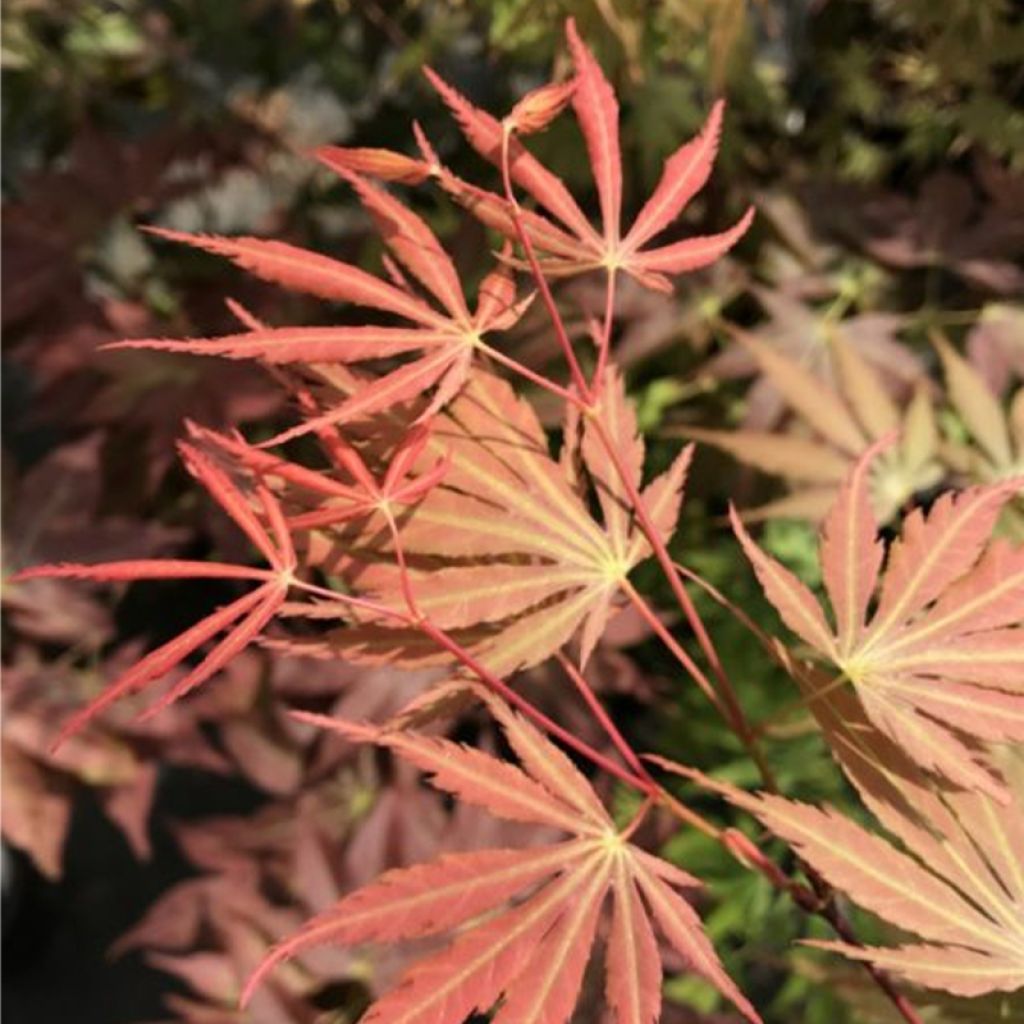

Acer palmatum Orange Flame - Japanese Maple


Acer palmatum Orange Flame - Japanese Maple


Acer palmatum Orange Flame - Japanese Maple
Acer palmatum Orange Flame - Japanese Maple
Acer palmatum Orange Flame
Japanese Maple, Palmate Maple
Why not try an alternative variety in stock?
View all →This plant carries a 24 months recovery warranty
More information
We guarantee the quality of our plants for a full growing cycle, and will replace at our expense any plant that fails to recover under normal climatic and planting conditions.
From €5.90 for pickup delivery and €6.90 for home delivery
Express home delivery from €8.90.
Delivery to Corse prohibited: UE law prohibits the import of this plant from mainland France to Corse as part of the fight against Xylella fastidiosa. Please accept our sincere apologies.
More information
Does this plant fit my garden?
Set up your Plantfit profile →
Description
Acer palmatum 'Orange Flame' is one of the most sought-after varieties of Japanese maple. Its beautifully dissected foliage emerges in spring in shades of orange before turning green during the growing season. In autumn, it turns yellow, orange, and red in a magnificent combination of warm colours. A large bush with vigorous growth, it reaches a height of 3.5m (12ft) in 10 years with a spread of 2.5m (8ft) and an ovate to ovoid habit. Like other Japanese maples, it thrives in acidic to neutral soil, in full sun or partial shade, and sheltered from the wind.
Native to eastern China, Korea, and Japan, Acer palmatum is the origin of a multitude of horticultural varieties that compete in beauty. Japanese maple now belongs, like all maples, to the Sapindaceae family (formerly classified Aceraceae). It is hardy (-20°C (-4°F)), but it dislikes dry and cold winds, scorching exposures, and dry and chalky soils.
The 'Orange Flame' cultivar exhibits relatively fast growth compared to other species in the genus. Its habit is quite irregular, more or less ovoid or spreading depending on the individual, with a good foliage density. Reaching about 3.5m (12ft) in height in 10 years, it will reach a height of 4.5 or 5m (15 or 16ft) at maturity, with a width of about 2 to 3m (7 to 10ft), thus forming a highly visible mass of vegetation and making it suitable for solitary use.
In spring, this Japanese maple produces young palmate leaves with 7 deeply cut lobes, in a beautiful orange colour. They then gradually turn green, a colour they retain throughout the growing season. In autumn, the foliage explodes in a festival of yellow, orange, and red.
Acer palmatum 'Orange Flame' is not strictly speaking an acidic-soil plant, but it prefers humus-rich and moisture-retaining soils. It dislikes atmospheric drought and thrives in oceanic climates as long as it is protected from the wind. Elsewhere, it is important to ensure a certain level of humidity by mulching the soil above its roots and monitoring watering, especially in summer. In hot and sunny climates, it is best to choose a partially shaded exposure to protect it from the harsh rays of the sun. In small gardens, it can be used as a standalone plant on a lawn. It can also be positioned in the centre or even at the back of a mixed border or on the edge of large trees to provide some shade and protection against prevailing winds.
In mild climates, it can be happily paired with Loropetalum chinense 'Pipa's Red', whose purple foliage will complement the warm colours of the maple. Physocarpus opulifolius 'Amber Jubilee' will also be a good companion with its colourful and changing foliage throughout the year. A black elder with purple leaves will provide a strong colour contrast with foliage that is just as deeply cut as that of our 'Orange Flame' maple.
Report an error about the product description
Acer palmatum Orange Flame - Japanese Maple in pictures
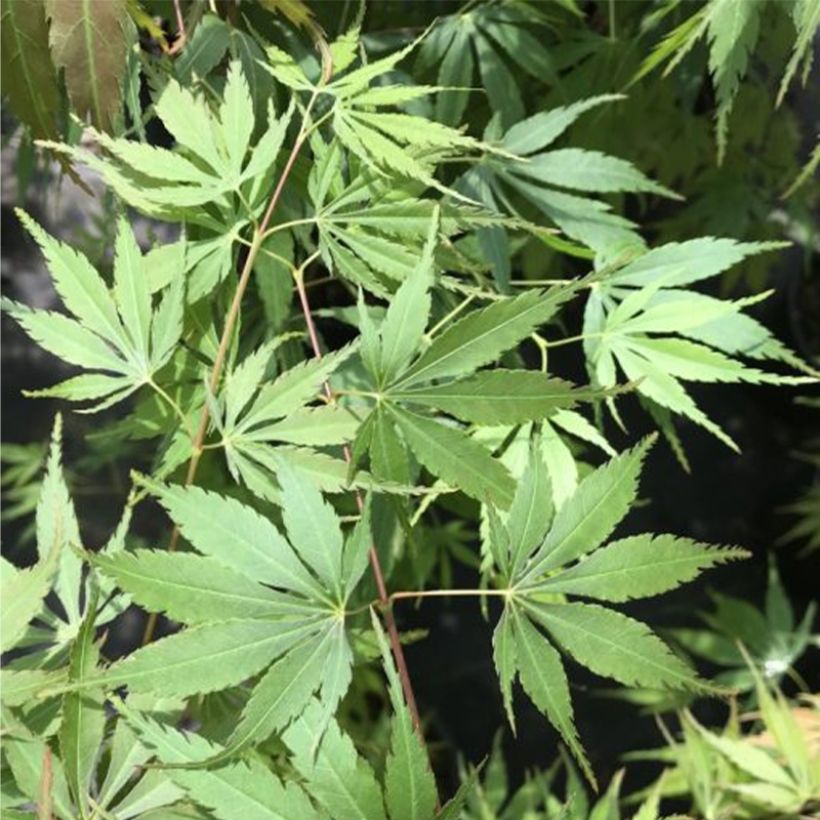



Plant habit
Flowering
Foliage
Botanical data
Acer
palmatum
Orange Flame
Sapindaceae
Japanese Maple, Palmate Maple
Cultivar or hybrid
Other Japanese Maples
Planting and care
Plant in spring or autumn in preferably light, humus-rich, neutral to acidic, deep, loose and well-drained soil. It should be placed in a sunny or partially shaded position in warm climates, sheltered from cold and dry winds that could dry out its foliage. The soil should be kept moist with mulching in summer, if necessary, especially when the plant is exposed to the sun, but should not be waterlogged in winter. Apply a significant amount of organic matter every 3 years to ensure a good humus content in the soil. Mulch, water, and mist the foliage on hot evenings. Monitor the appearance of scale insects, as well as Verticillium wilt in the soil, a fungal disease that occurs in heavy and overly wet soil (this risk is eliminated in containers).
Planting period
Intended location
Care
This item has not been reviewed yet - be the first to leave a review about it.
Haven't found what you were looking for?
Hardiness is the lowest winter temperature a plant can endure without suffering serious damage or even dying. However, hardiness is affected by location (a sheltered area, such as a patio), protection (winter cover) and soil type (hardiness is improved by well-drained soil).

Photo Sharing Terms & Conditions
In order to encourage gardeners to interact and share their experiences, Promesse de fleurs offers various media enabling content to be uploaded onto its Site - in particular via the ‘Photo sharing’ module.
The User agrees to refrain from:
- Posting any content that is illegal, prejudicial, insulting, racist, inciteful to hatred, revisionist, contrary to public decency, that infringes on privacy or on the privacy rights of third parties, in particular the publicity rights of persons and goods, intellectual property rights, or the right to privacy.
- Submitting content on behalf of a third party;
- Impersonate the identity of a third party and/or publish any personal information about a third party;
In general, the User undertakes to refrain from any unethical behaviour.
All Content (in particular text, comments, files, images, photos, videos, creative works, etc.), which may be subject to property or intellectual property rights, image or other private rights, shall remain the property of the User, subject to the limited rights granted by the terms of the licence granted by Promesse de fleurs as stated below. Users are at liberty to publish or not to publish such Content on the Site, notably via the ‘Photo Sharing’ facility, and accept that this Content shall be made public and freely accessible, notably on the Internet.
Users further acknowledge, undertake to have ,and guarantee that they hold all necessary rights and permissions to publish such material on the Site, in particular with regard to the legislation in force pertaining to any privacy, property, intellectual property, image, or contractual rights, or rights of any other nature. By publishing such Content on the Site, Users acknowledge accepting full liability as publishers of the Content within the meaning of the law, and grant Promesse de fleurs, free of charge, an inclusive, worldwide licence for the said Content for the entire duration of its publication, including all reproduction, representation, up/downloading, displaying, performing, transmission, and storage rights.
Users also grant permission for their name to be linked to the Content and accept that this link may not always be made available.
By engaging in posting material, Users consent to their Content becoming automatically accessible on the Internet, in particular on other sites and/or blogs and/or web pages of the Promesse de fleurs site, including in particular social pages and the Promesse de fleurs catalogue.
Users may secure the removal of entrusted content free of charge by issuing a simple request via our contact form.
The flowering period indicated on our website applies to countries and regions located in USDA zone 8 (France, the United Kingdom, Ireland, the Netherlands, etc.)
It will vary according to where you live:
- In zones 9 to 10 (Italy, Spain, Greece, etc.), flowering will occur about 2 to 4 weeks earlier.
- In zones 6 to 7 (Germany, Poland, Slovenia, and lower mountainous regions), flowering will be delayed by 2 to 3 weeks.
- In zone 5 (Central Europe, Scandinavia), blooming will be delayed by 3 to 5 weeks.
In temperate climates, pruning of spring-flowering shrubs (forsythia, spireas, etc.) should be done just after flowering.
Pruning of summer-flowering shrubs (Indian Lilac, Perovskia, etc.) can be done in winter or spring.
In cold regions as well as with frost-sensitive plants, avoid pruning too early when severe frosts may still occur.
The planting period indicated on our website applies to countries and regions located in USDA zone 8 (France, United Kingdom, Ireland, Netherlands).
It will vary according to where you live:
- In Mediterranean zones (Marseille, Madrid, Milan, etc.), autumn and winter are the best planting periods.
- In continental zones (Strasbourg, Munich, Vienna, etc.), delay planting by 2 to 3 weeks in spring and bring it forward by 2 to 4 weeks in autumn.
- In mountainous regions (the Alps, Pyrenees, Carpathians, etc.), it is best to plant in late spring (May-June) or late summer (August-September).
The harvesting period indicated on our website applies to countries and regions in USDA zone 8 (France, England, Ireland, the Netherlands).
In colder areas (Scandinavia, Poland, Austria...) fruit and vegetable harvests are likely to be delayed by 3-4 weeks.
In warmer areas (Italy, Spain, Greece, etc.), harvesting will probably take place earlier, depending on weather conditions.
The sowing periods indicated on our website apply to countries and regions within USDA Zone 8 (France, UK, Ireland, Netherlands).
In colder areas (Scandinavia, Poland, Austria...), delay any outdoor sowing by 3-4 weeks, or sow under glass.
In warmer climes (Italy, Spain, Greece, etc.), bring outdoor sowing forward by a few weeks.





































